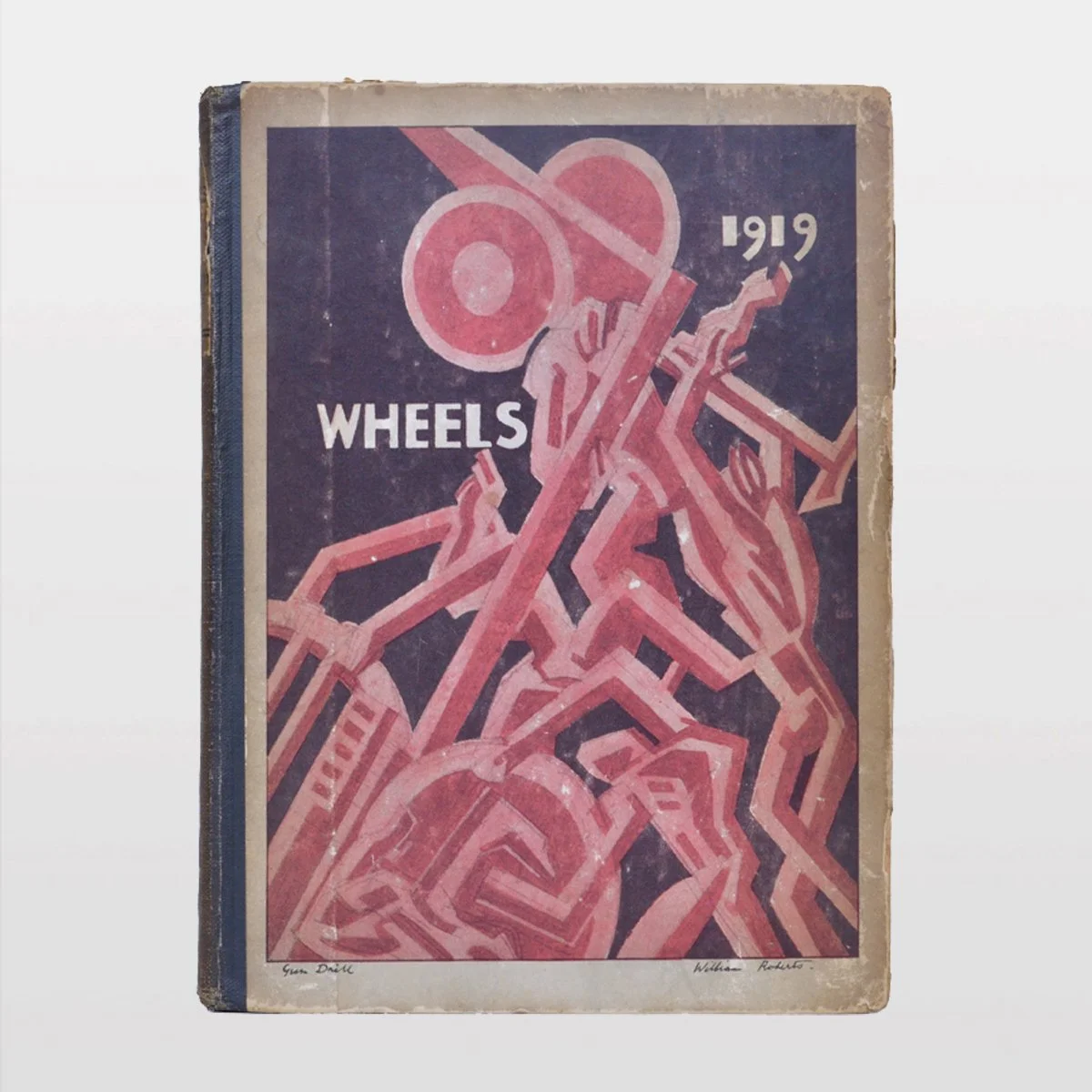 Image 1 of 4
Image 1 of 4

 Image 2 of 4
Image 2 of 4

 Image 3 of 4
Image 3 of 4

 Image 4 of 4
Image 4 of 4





WHEELS 1919. SITWELL (Edith).
JOHN BANTING'S COPY
WHEELS 1919 Fourth Cycle.
Cover design by William Roberts.
First edition. 8vo. [189 x 138 x 12 mm]. 102, [1] pp. Paper covered boards featuring a colour design titled Gun Drill, by William Roberts, cloth spine with printed paper label, coloured endleaves also designed by Roberts. (A little rubbed and soiled, with minor fraying around board edges, spine faded and label browned and chipped.)
Oxford: B. H. Blackwell, 1919
The flaws to the binding are minor and the inside is fine, with a few pages showing creases from the printing.
Ownership inscription in blue pencil to the front fly leaf reading: "John Banting 2/22". John Banting (1902-1972), the son of a commercial bookbinder and teacher, became a celebrated surrealist artist and a writer who held close connections with the Bloomsbury group. Born in Chelsea, Banting was heavily influenced by Vorticism, which was shown in his early poems and drawings. He attended classes at Vincent Square art school under Bernard Meninsky in 1921 and the free academies in Paris, including the Grande Chaumiere and Academie Colarossi in 1922. By 1925 he had established a studio in Fitzroy Street and was associated with the Bloomsbury group; producing dust jacket designs for Leonard and Virginia Woolf's Hogarth Press and for the ballets Pomona in 1929 and Prometheus in 1936 at Sadler's Wells. Whilst living in Paris in 1930, Banting was drawn to Surrealism after meeting with the likes of Duchamp, Breton, Giacometti and Crevel. Their influence was reflected in Banting's exhibition at the Wertheim Gallery in 1931, as well as the London International Surrealist Exhibition in 1936 and his contribution (at the invitation of Duchamp), to the Exposition Internationale du Surrealisme in 1938. In a 1985 Daily Telegraph article, Anthony Powell lauded him as "the only true English surrealist painter".
Dedicated to the memory of Wilfred Owen MC, Wheels 1919: The Fourth Cycle, notably published seven of Owen's poems for the first time, a year prior to Owen's first collected works, titled: Poems, which was edited by Siegfried Sassoon (with the assistance of Edith Sitwell) and published by Chatto and Windus in 1920. The poems published for the first time in Wheels 1919 are: The Show, Strange Meeting, A Terre, The Sentry, Disabled, The Dead-Beat and The Chances.
Other poets to feature in this publication include: Osbert, Edith and Sacheverell Sitwell, Aldous Huxley, Arnold James, Iris Tree, Sherard Vines and Francesco Quevedo.
Stock no. ebc8863
JOHN BANTING'S COPY
WHEELS 1919 Fourth Cycle.
Cover design by William Roberts.
First edition. 8vo. [189 x 138 x 12 mm]. 102, [1] pp. Paper covered boards featuring a colour design titled Gun Drill, by William Roberts, cloth spine with printed paper label, coloured endleaves also designed by Roberts. (A little rubbed and soiled, with minor fraying around board edges, spine faded and label browned and chipped.)
Oxford: B. H. Blackwell, 1919
The flaws to the binding are minor and the inside is fine, with a few pages showing creases from the printing.
Ownership inscription in blue pencil to the front fly leaf reading: "John Banting 2/22". John Banting (1902-1972), the son of a commercial bookbinder and teacher, became a celebrated surrealist artist and a writer who held close connections with the Bloomsbury group. Born in Chelsea, Banting was heavily influenced by Vorticism, which was shown in his early poems and drawings. He attended classes at Vincent Square art school under Bernard Meninsky in 1921 and the free academies in Paris, including the Grande Chaumiere and Academie Colarossi in 1922. By 1925 he had established a studio in Fitzroy Street and was associated with the Bloomsbury group; producing dust jacket designs for Leonard and Virginia Woolf's Hogarth Press and for the ballets Pomona in 1929 and Prometheus in 1936 at Sadler's Wells. Whilst living in Paris in 1930, Banting was drawn to Surrealism after meeting with the likes of Duchamp, Breton, Giacometti and Crevel. Their influence was reflected in Banting's exhibition at the Wertheim Gallery in 1931, as well as the London International Surrealist Exhibition in 1936 and his contribution (at the invitation of Duchamp), to the Exposition Internationale du Surrealisme in 1938. In a 1985 Daily Telegraph article, Anthony Powell lauded him as "the only true English surrealist painter".
Dedicated to the memory of Wilfred Owen MC, Wheels 1919: The Fourth Cycle, notably published seven of Owen's poems for the first time, a year prior to Owen's first collected works, titled: Poems, which was edited by Siegfried Sassoon (with the assistance of Edith Sitwell) and published by Chatto and Windus in 1920. The poems published for the first time in Wheels 1919 are: The Show, Strange Meeting, A Terre, The Sentry, Disabled, The Dead-Beat and The Chances.
Other poets to feature in this publication include: Osbert, Edith and Sacheverell Sitwell, Aldous Huxley, Arnold James, Iris Tree, Sherard Vines and Francesco Quevedo.
Stock no. ebc8863
